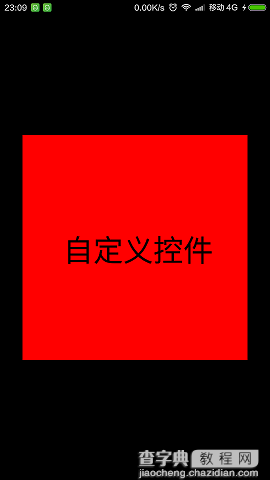本文实例分析了Android重写View并自定义属性的方法。分享给大家供大家参考,具体如下:
这里通过自定义属性 实现如下图所示效果:

第一步:在resvalues的目录下新建一个文件attrs.xml
声明一些自定义属性
<"1.0" encoding="utf-8"?> <resources> <declare-styleable name="CustomViewStyle"> <attr name="customText" format="string" /> <attr name="customTextColor" format="color" /> <attr name="customTextSize" format="dimension" /> </declare-styleable> </resources>
第二步:在layout目录下新建布局文件activity_main.xml
特别注意要在外层控件加上这个声明:
格式:xmlns:(你自定义名称)="http://schemas.android.com/apk/(你应用的包名)"
xmlns:xr="http://schemas.android.com/apk/res/com.rong.test"
或者
xmlns:xr="http://schemas.android.com/apk/res-auto"
推荐使用第二种
在布局文件中加入这些自定义的属性:
<"1.0" encoding="utf-8"?> <RelativeLayout xmlns:android="http://schemas.android.com/apk/res/android" xmlns:xr="http://schemas.android.com/apk/res/com.rong.test" android:layout_width="match_parent" android:layout_height="match_parent" android:background="@android:color/black" android:orientation="vertical" > <com.rong.activity.CustomView android:layout_width="300dp" android:layout_height="300dp" android:layout_centerInParent="true" android:background="#ff0000" xr:customText="自定义控件" xr:customTextColor="#000000" xr:customTextSize="40sp" /> </RelativeLayout>
第三部继承View重写
package com.rong.activity; import com.rong.test.R; import android.content.Context; import android.content.res.TypedArray; import android.graphics.Canvas; import android.graphics.Color; import android.graphics.Paint; import android.graphics.Rect; import android.util.AttributeSet; import android.view.View; /** * 自定义控件 * * @author 徐荣 * */ public class CustomView extends View { /** * 自定义画笔 */ private Paint mPaint; /** * 文字范围 */ private Rect mBounds; /** * 自定义文字 */ private String customText; /** * 自定义大小 */ private int customTextSize; /** * 自定义颜色 */ private int customTextColor; public CustomView(Context context, AttributeSet attrs) { super(context, attrs); TypedArray typedArray = context.obtainStyledAttributes(attrs, R.styleable.CustomViewStyle); // 获取自定义文字 customText = typedArray.getString(R.styleable.CustomViewStyle_customText); // 获取自定义文字大小 customTextSize = typedArray.getDimensionPixelSize(R.styleable.CustomViewStyle_customTextSize, 28); // 或者自定义文字颜色 customTextColor = typedArray.getColor(R.styleable.CustomViewStyle_customTextColor, Color.WHITE); // 要回收这个typedArray对象 typedArray.recycle(); initView(); } public void initView() { // 初始化画笔 mPaint = new Paint(); mPaint.setAntiAlias(true); mPaint.setStyle(Paint.Style.FILL); mPaint.setColor(customTextColor); mPaint.setTextSize(customTextSize); // 生成文字区域 mBounds = new Rect(); } @Override protected void onDraw(Canvas canvas) { super.onDraw(canvas); // 获取文字显示区域mBounds mPaint.getTextBounds(customText, 0, customText.length(), mBounds); //使文字宽居中显示=控件的宽度/2 -文字的宽度/2 float helfWidth = getWidth() / 2 - mBounds.width() / 2; //使文字高居中显示=控件的宽度/2 +文字的宽度/2 float helfHeight = getHeight() / 2+mBounds.height()/2; //绘制文字 canvas.drawText(customText, helfWidth, helfHeight, mPaint); } }
运行!
希望本文所述对大家Android程序设计有所帮助。


